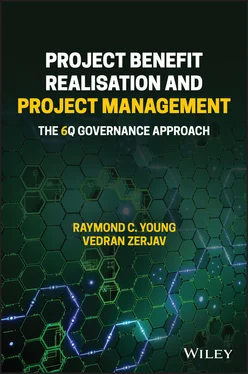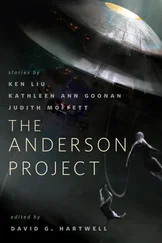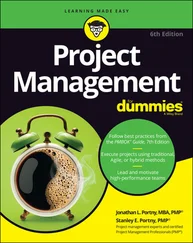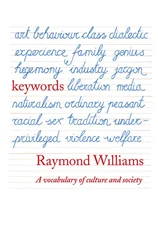So, what is the lesson to be learned for executives here looking at infrastructure and megaprojects? We surely are not trying to teach you here how to govern a £1B+ beast, but we do want you to learn from the experience of trying to tame such beasts. There are a few things we can induce here. It is that projects are more fragile, the more they grow and more complex they become [27]. The second thing is that they evolve with time. The third point is that no matter how hard you try to nail down the specs, it will change. The fourth point is that the project will not only have its immediate benefits but there will be wider externalities that are captured beyond the boundary of the projects. So, what is the solution learning from infrastructure implementation programmes? The short answer is a lot. Most importantly, it allows us to say that governance structures can be designed upfront. We can design our projects by looking at the organisation that delivers them and their alignment between the strategy, policy, and operations.
Design Thinking for Project Governance
The final key concept we want to touch on briefly is design thinking. We believe the role of the accidental project sponsor is as a reflective practitioner [28] or a painter who engages with the canvas in a reflective conversation and by so doing, creates something that has not existed before – the artificial [29]. In this sense, the argument of this book will be based on the idea that projects are designed in an interactive and stepwise manner rather than implemented based on a pre‐existing plan. In our experience, we have seen many a project being implemented for no real strategic purpose in terms of benefits realisation. This was always wrong, and it will be even more wrong in the post‐2020 pandemic world of projects where investments in any capacity upgrades, assets, or product developments are likely to be scrutinised even more. It is much more likely that there will be more effort in the front end of the project where strategic decisions are made to decide about which project to sanction and equally to set up its governance and organisational structure. For this reason, it is likely that we will need more flexibility and agility in the project development process and that we will have portfolios comprising larger numbers of smaller projects brought together in a modular fashion.
There are two main theoretical points we would like to drive home here. And that is that (i) projects are designed as solutions to policy or business problems. And that (ii) these problems are only seldom straightforward and well‐structured. More often than not, they would be what we call ‘wicked’ [30]. Wicked not in the sense of evil and morally wrong but wicked in the sense of playfully mischievous. The term ‘wicked problem’ was originally coined in the context of town planning but was then expanded to include all sorts of political, economic, and social problem‐solving. Some of the most obvious differences between tame and wicked problems are that the former are describable and determinate, whilst in the latter, problem definition incorporates solution and only indeterminate solutions can be achieved. Design, on the other hand, can be seen as a combination of framing and problem‐solving [31] and so can be project management [32].
This book will draw on the main principles of design and design thinking and apply them to the context of projects as they are likely to be needed rather than the traditional top‐down mindset focused on on‐time and to budget. The main premise is that we think of projects as solutions to problems that need to be designed rather than taken for granted as is sometimes the case.
1 1 Hilmer, F.G. (1993). Strictly Boardroom: Improving Governance to Enhance Company Performance. Melbourne: The Business Library.
2 2 Cadbury (1992). The Financial Aspects of Corporate Governance. London: Gee.
3 3 Kwak, Y.H. and Anbari, F.T. (2009). Analyzing project management research: perspectives from top management journals. Int. J. Proj. Manag. 27 (5): 435–446.
4 4 Mankins, M.C. and Steele, R. (2005). Turning great strategy into great performance. Harv. Bus. Rev. 83 (7–8): 64.
5 5 Kiechell, W. (2010). The Lords of Strategy. Boston: Harvard Business Press.
6 6 Lovallo, D. and Kahneman, D. (2003). Delusions of success: how optimism undermines executive's decisions. Harv. Bus. Rev. 81 (7): 56–63.
7 7 Young, R. (2006). What is the ROI for IT Project Governance? Establishing a benchmark. 2006 IT Governance International Conference, Auckland, New Zealand (November 2006).
8 8 Young, R. and Grant, J. (2015). Is strategy implemented by projects? Disturbing evidence in the state of NSW. Int. J. Proj. Manag. 33 (1): 15–28.
9 9 Young, R., Young, M., Jordan, E., and O’Connor, P. (2012). Is strategy being implemented through projects? Contrary evidence from a leader in New Public Management. Int. J. Proj. Manag. 30 (8): 887–900.
10 10 Starkweather, J.A. and Stevenson, D.H. (2011). PMP® certification as a core competency: necessary but not sufficient. Proj. Manag. J. 42 (1): 31–41.
11 11 Joseph, N. and Marnewick, C. (2018). Investing in project management certification: do organisations get their money's worth? Inf. Technol. Manag. 19 (1): 51–74.
12 12 Baccarini, D. (1999). The logical framework for defining project success. Proj. Manag. J. 30 (4): 25–32.
13 13 Young, R. and Poon, S. (2013). Top management support‐almost always necessary and sometimes sufficient for success: findings from a fuzzy set analysis. Int. J. Proj. Manag. 31 (7): 943–957.
14 14 Young, R. and Jordan, E. (2008). Top management support: mantra or necessity? Int. J. Proj. Manag. 26 (7): 713–725.
15 15 ISO 38500 (2008). Corporate Governance of Information Technology. International Standards Organisation.
16 16 Standards Australia (2006). HB280 Case Studies – How Boards and Senior Management Have Governed ICT Projects to Succeed (or Fail). Sydney: Standards Australia.
17 17 Young, R., Chen, W., Quazi, A. et al. (2019). The relationship between project governance mechanisms and project success? An international dataset. Int. J. Manag. Proj. Bus. 13 (7): 1496–1521.
18 18 Watson, J. and Everett, J.E. (1996). Do small businesses have high failure rates? J. Small Bus. Manag. 34 (4): 45.
19 19 Booz Allen Hamilton. Too Much SOX Can Kill You Resolving the Compliance Paradox [Internet]. 2004 [cited 2016 Aug 9]. Available from: https://www.boozallen.com/content/dam/boozallen/media/file/143161.pdf
20 20 Stewart, J. (2004). The meaning of strategy in the public sector. Aust. J. Public Adm. 63 (4): 16–21.
21 21 Crawford, L. (2005). Senior management perceptions of project management competence. Int. J. Proj. Manag. 23 (1): 7–16.
22 22 KPMG (2005). Global IT Project Management Survey: How Committed Are You? KPMG.
23 23 Deloitte (2007). What the Board Needs to Know About IT: Phase II Findings: Maximizing Performance Through IT Strategy. Deloitte LLP.
24 24 Young, R. and Poon, S. (2013). TOP MANAGEMENT SUPPORT – almost always NECESSARY AND sometimes SUFFICIENT for success: findings from a fuzzy set analysis. Int. J. Proj. Manag. 31: 943–957.
25 25 Flyvbjerg, B. and Sunstein, C.R. (2016). The principle of the malevolent hiding hand; or, the planning fallacy writ large. Soc. Res. (New. York). 83 (4): 979–1004.
26 26 Flyvbjerg, B. (2014). What you should know about megaprojects and why: an overview. Proj. Manag. J. 45 (2): 6–19.
27 27 Ansar, A., Flyvbjerg, B., Budzier, A., and Lunn, D. (2016). Does infrastructure investment lead to economic growth or economic fragility? Evidence from China. Oxford Rev. Econ. Policy 32 (3): 360–390.
28 28 Schön, D.A. (1983). The Reflective Practitioner: How Professionals Think in Action. London: Temple Smith.
Читать дальше












